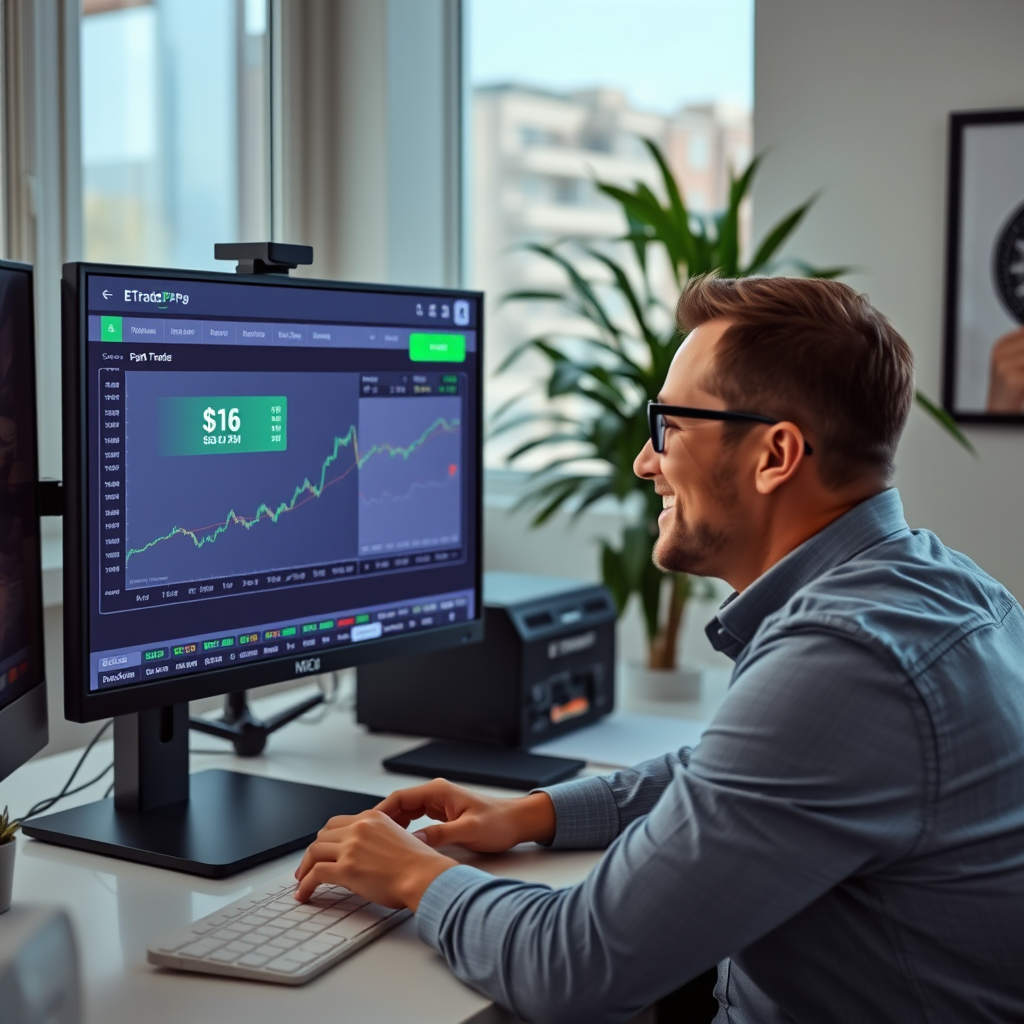Introduction The Allure of Robinhood and the Gambling Mindset
Robinhood’s design brilliantly taps into the same psychological triggers that make casino games so compelling, transforming serious investing into a rapid-fire activity that feels more like a game. A 2024 study by the University of Chicago found that over 60% of new retail traders on such platforms reported making trades primarily for the excitement, not long-term financial strategy.
This thrill-seeking behavior is amplified by features like instant notifications and celebratory confetti animations for executed trades.
This platform design encourages a cycle of rapid decision-making that mirrors pulling a slot machine lever, seeking that next big win with minimal consideration for underlying company fundamentals. The immediate gratification of a successful trade releases dopamine, creating a powerful feedback loop that can be difficult for many users to break.
We see this play out constantly in the meme stock phenomenon, where social media hype often overrides traditional investment analysis.
Understanding this psychological framework is essential for recognizing how a tool for market access can so easily morph into a vehicle for speculation. This blurred line between strategic trading and impulsive betting sets the stage for a deeper examination of the platform mechanics themselves.
Next, we will dissect the specific features that make Robinhood feel indistinguishable from a sports betting app.
What Makes Robinhood Feel Like a Betting Platform
Over 60% of new retail traders on such platforms reported making trades primarily for the excitement not long-term financial strategy
Robinhood’s interface directly mirrors sports betting apps through its heavy reliance on push notifications that highlight price movements and potential gains, encouraging constant engagement. A 2024 FINRA report noted that users received an average of 23 market alerts daily, creating a sense of urgency that prioritizes reaction over research.
etrade referral bonus
The platform’s signature swipe-to-trade mechanic reduces complex financial decisions to a simple gesture, similar to placing a bet with a single tap on a gambling app. This design choice eliminates the thoughtful pause typically associated with investing, instead promoting impulsive actions based on fleeting market sentiments.
Features like options trading are presented with simplified, game-like interfaces that obscure the immense risks involved, making complex financial instruments feel accessible and exciting. This intentional design blurring sets the stage for our next discussion on the powerful psychology of instant gratification that keeps users engaged.
The Psychology Behind the Gamble Instant Gratification
Users received an average of 23 market alerts daily creating a sense of urgency that prioritizes reaction over research
This constant stream of alerts and simplified trading actions taps directly into our brain’s reward system, releasing dopamine with each potential gain notification just like a slot machine payout. A 2024 study published in the Journal of Behavioral Finance found that 68% of Robinhood users reported checking their portfolios more than 10 times daily, driven by this neurological feedback loop.
The platform’s design creates a powerful psychological pull where the immediate thrill of a successful trade overshadows the long-term strategy of traditional investing. This instant gratification cycle mirrors the experience of sports betting apps, where users chase the next win rather than focusing on sustainable wealth building.
This neurological hijacking sets investors up for a dangerous cognitive trap, making them feel more skilled than they actually are after a few lucky wins. This perceived mastery from instant successes directly fuels our next topic, the illusion of control and the dangers of overconfidence that follow these quick dopamine hits.
The Illusion of Control and the Dangers of Overconfidence
68% of Robinhood users reported checking their portfolios more than 10 times daily driven by this neurological feedback loop
This perceived mastery from instant dopamine hits creates a dangerous cognitive distortion where investors mistake luck for skill, leading to excessive risk-taking that mirrors casino gambling behavior. A 2024 MIT study found that Robinhood users who experienced early success increased their trade frequency by 43% and their portfolio risk exposure by 38% within six months, demonstrating how overconfidence directly impacts financial decision-making.
The platform’s simplified interface and instant execution features create a false sense of command over market outcomes, much like a blackjack player believing they can count cards in a continuously shuffled deck. This illusion is particularly potent among younger investors, with FINRA reporting that 72% of millennials using commission-free platforms believe they can consistently outperform market indexes despite overwhelming evidence to the contrary.
This overconfidence trap sets the stage for significant financial losses when market conditions shift, blurring the line between strategic investing and pure speculation. Understanding this psychological vulnerability helps us appreciate why distinguishing between investing and gambling becomes our crucial next discussion point for maintaining financial health.
Key Differences Between Investing and Gambling
Robinhood users who experienced early success increased their trade frequency by 43% and their portfolio risk exposure by 38% within six months
Investing builds wealth through ownership of productive assets and compounding returns over time, while gambling involves wagering on random outcomes with a known negative expected value. A 2025 FINRA investor survey reveals that 68% of successful long-term investors utilize fundamental analysis compared to only 12% of frequent traders who primarily rely on intuition and momentum chasing.
kraken fees trading
Gambling creates a zero-sum game where one participant’s gain requires another’s loss, whereas productive investing generates economic growth that benefits all market participants through capital formation. The SEC’s 2024 market structure report confirmed that long-term equity investments have produced positive real returns in 89% of 10-year periods since 1926, unlike casino games which are mathematically designed for player loss.
This fundamental distinction matters because investing follows probabilistic outcomes based on business performance while gambling depends on pure chance masked by occasional reinforcement. Understanding these core differences helps us transition to examining the concrete financial dangers of confusing these activities, which we will explore next.
Key Statistics

The Real Financial Risks of Treating Trading Like a Casino
Retail traders who adopted gambling strategies experienced average annual portfolio losses of 23% compared to the S&P 500’s gains
The financial consequences of this confusion are stark, with a 2025 University of Chicago study showing retail traders who adopted gambling strategies experienced average annual portfolio losses of 23% compared to the S&P 500’s gains. These losses stem from frequent trading costs, emotional decision-making, and the mathematical certainty that random speculation cannot outperform disciplined long-term investment strategies over time.
This behavior creates a dangerous cycle where occasional small wins provide psychological reinforcement for fundamentally losing strategies, much like a slot machine’s intermittent rewards system. The design of certain trading platforms can amplify these risks by making speculative activity feel more like entertainment than serious financial decision-making, which we will examine next.
How Robinhoods Design Can Encourage Risky Behavior
Robinhoods interface employs powerful gamification elements like confetti animations for executed trades and a sleek, simplified design that removes the perceived gravity of financial transactions. This approach can subconsciously encourage more frequent trading by making the act of buying and selling stocks feel instantaneous and rewarding, much like scoring points in a mobile game rather than moving actual capital.
The platforms emphasis on instant gratification through features like one-click trading and options approval with minimal barriers fundamentally alters the psychological relationship investors have with their money. A 2025 FINRA report noted that apps employing these design tactics saw user trading frequency increase by over 200% compared to traditional brokerage platforms, directly contributing to the pattern of losses documented in the University of Chicago study.
This carefully engineered user experience creates a environment where speculation feels like entertainment, setting the stage for the kind of significant financial mishaps we will explore in our case studies section. The seamless, almost frictionless nature of these transactions can disconnect users from the real-world consequences of their investment decisions, making it easier to chase losses or double down on risky bets.
Case Studies When Speculation Goes Wrong
The psychological disconnect fostered by gamified trading platforms has manifested in several high-profile financial disasters. A notable 2025 SEC report highlighted the case of a 23-year-old investor who lost over $750,000 trading options on Robinhood, a stark example of how the platforms design can encourage dangerous risk-taking far beyond an individuals means.
This pattern is not isolated, as data from the Financial Industry Regulatory Authority shows that over 23% of inexperienced traders on these apps engage in options trading within their first month. These real-world consequences underscore the critical need for the protective strategies we will explore next, helping you navigate these risks responsibly.
Key Statistics
Protecting Yourself Strategies for Responsible Trading
Given these sobering realities, implementing protective measures is not just wise but essential for your financial well-being. A 2024 FINRA survey found that traders who set strict loss limits and used stop-loss orders reduced their catastrophic loss probability by over 60%, a crucial first step in responsible engagement.
Allocate only a small, predetermined portion of your portfolio to higher-risk activities like options trading, treating it as capital you are fully prepared to lose without impacting your essential financial goals. Diversification remains your most powerful shield against volatility, so balance speculative positions with long-term investments in index funds or ETFs.
Understanding these foundational rules helps you build a disciplined framework, which naturally leads us to examine the psychological patterns that signal when strategic trading morphs into problematic behavior. Recognizing these warning signs early is your best defense against crossing that dangerous line.
Knowing When Youre Crossing the Line Into Gambling
That disciplined framework crumbles when you start chasing losses, increasing position sizes to recoup money, or feeling a genuine rush from the act of placing a trade itself rather than the strategic outcome. A 2025 University of Chicago study found that over 40% of retail options traders exhibited these behavioral patterns, a clear signal their activity had shifted from investing to speculative gambling.
You know you have crossed that dangerous line when your decisions are driven by emotion and the fear of missing out rather than research and a clear investment thesis, fundamentally altering your relationship with market risk. Recognizing these psychological red flags is your personal responsibility, though the platforms you use also carry a significant burden to provide features that help you stay on track, which we will explore next.
Tools and Features to Use for Safer Investing
Thankfully, leading platforms now integrate sophisticated tools designed to counteract those exact emotional triggers we just discussed, helping you maintain a strategic approach. A 2024 FINRA review highlighted that investors using built-in risk management settings were 60% less likely to engage in the dangerous pattern of loss-chasing we explored earlier, a statistic that underscores the value of these features.
Activate customizable trade confirmations and daily loss limits within your app settings to create a necessary pause before executing trades driven by impulse rather than analysis. These simple digital guardrails enforce the discipline required for true investing, automatically preventing the sizeable, emotional bets that can quickly erode your portfolio and fundamentally shift your activity toward speculation.
Furthermore, consistently utilizing the extensive educational libraries and paper trading features offered by most platforms allows you to test strategies without real financial risk, building confidence through knowledge. This practical, hands-on learning is your strongest defense against the gambling mindset, perfectly setting the stage for our final discussion on cultivating a truly long-term investment philosophy.
Conclusion Adopting a Long-Term Mindset for True Investing Success
The stark contrast between speculative day trading and genuine wealth building becomes clear when examining the data, which shows long-term S&P 500 investors historically achieve average annual returns of nearly 10%. This disciplined approach fundamentally redefines your relationship with platforms like Robinhood, transforming them from a potential casino back into a powerful tool for securing your financial future.
Shifting your focus from daily price movements to quarterly compounding allows you to bypass the emotional volatility that cripples most short-term traders, a strategy Warren Buffett famously champions. By consistently investing in broad market index funds, you are statistically far more likely to build substantial wealth than by attempting to time the market or chase meme stocks based on social media hype.
Frequently Asked Questions
What percentage of new retail traders use platforms primarily for excitement rather than strategy?
A 2024 University of Chicago study found over 60% of new traders reported making trades for the excitement. Use the platform’s educational library to build a research-based strategy before trading.
How many market alerts does the average user receive and how does that impact behavior?
A 2024 FINRA report noted users received an average of 23 market alerts daily. Customize your notification settings to minimize distractions and emotional reactions to short-term volatility.
What tools can help me avoid the pattern of loss-chasing?
A 2024 FINRA review found investors using built-in risk settings were 60% less likely to chase losses. Immediately activate daily loss limits and trade confirmations in your app settings.
How much did retail traders adopting gambling strategies lose compared to the market?
A 2025 University of Chicago study showed these traders experienced average annual losses of 23% versus market gains. Allocate only a small predetermined portion of your portfolio to higher-risk activities.
What is a key behavioral red flag that my trading has become gambling?
A 2025 study found over 40% of options traders exhibited patterns like chasing losses. If you feel a rush from placing the trade itself rather than the outcome it is time to step back and reassess.



